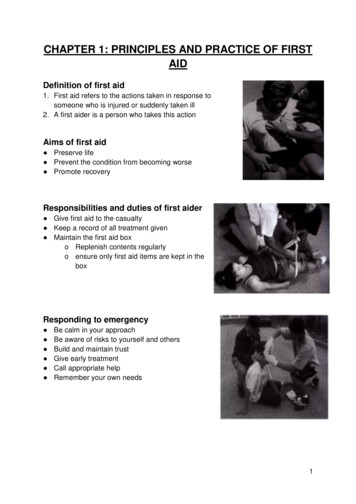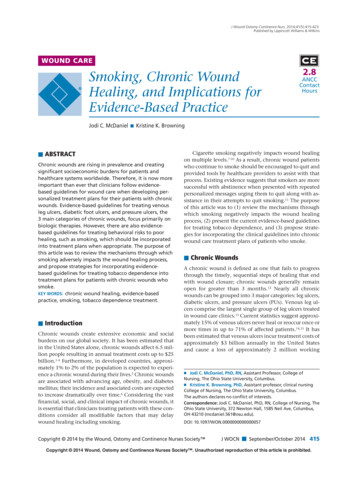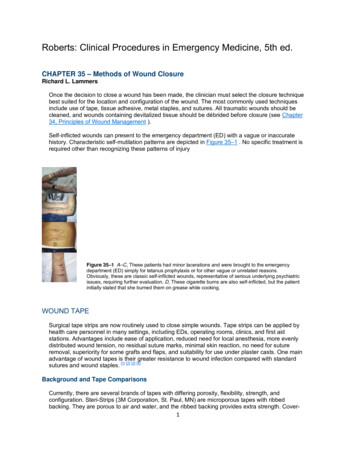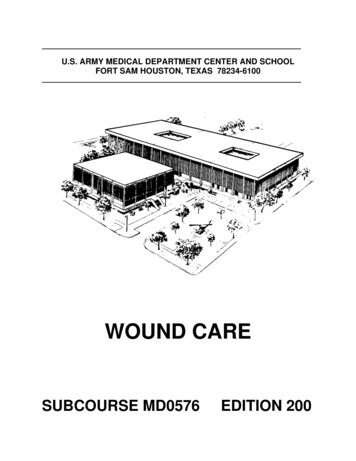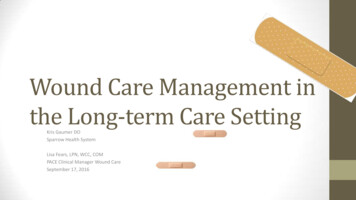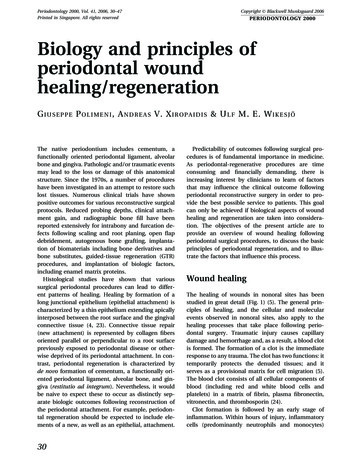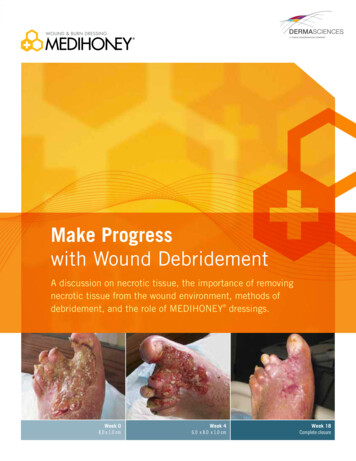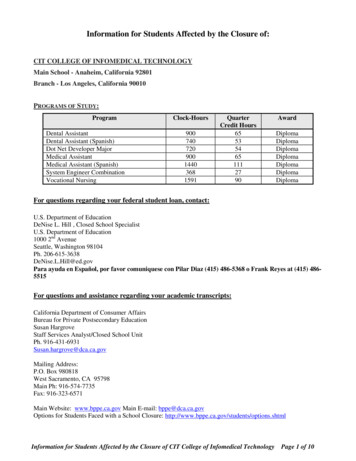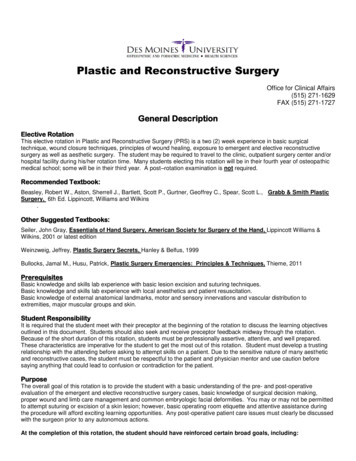Transcription
ETHICON Wound Closure ManualETHICON WOUND CLOSURE MANUAL . 1WOUND HEALING . 5Wound Closure Manual . 5THE WOUND . 7WOUND HEALING . 8Wound Healing . 8Patient Factors That Affect Wound Healing . 9Surgical Principles. 11CLASSIFICATIONS OF WOUNDS . 12TYPES OF WOUND HEALING . 14Types of Wound Healing . 14Healing By First Intention . 15Healing by Second Intention . 17Healing by Third Intention. 18COMPLICATIONS IN WOUND HEALING . 19IN THE NEXT SECTION . 20REFERENCES . 21THE SUTURE. 22WHAT IS A SUTURE? . 22PERSONAL SUTURE PREFERENCE . 22SUTURE CHARACTERISTICS . 24Suture Characteristics. 24Size and Tensile Strength . 25Monofilament vs. Multifiament Strands . 26Absorbable vs. Nonabsorbable Materials page 1 of 2 . 27Absorbable vs. Nonabsorbable Materials page 2 of 2 . 29SPECIFIC SUTURING MATERIALS . 29Specific Suturing Materials. 29Absorbable Sutures . 30Synthetic Absorbable Sutures. 31Nonabsorbable Sutures page 1 of 2 . 33Nonabsorbable Sutures page 2 of 2 . 34Synthetic Nonabsorbable Sutures . 35Suturing Options: Materials, Characteristics and Applications Table Part 1. 36Suturing Options: Materials, Characteristics and Applications Table Part 2. 38Suturing Options: Materials, Characteristics and Applications Table Part 3. 40COMMON SUTURING TECHNIQUES . 42Ligatures . 42The Primary Suture Line. 43The Secondary Suture Line . 46Stitch Placement. 47KNOT TYING TECHNIQUES . 48General Principles of Knot Tying . 48Suture Characteristics and Knot Security. 49Knot Tying Techniques Most Often Used. 49Endoscopic Knot Tying Techniques . 52Cutting Sutures. 53SUTURE REMOVAL. 54SUTURE HANDLING TIPS . 55SUTURE SELECTION BY PROCEDURE . 56Principles of Suture Selection . 56Surgery Within the Abdominal Cavity. 57Closing the Abdomen page 1 of 3 . 60Closing the Abdomen page 2 of 3 . 62
Closing the Abdomen page 3 of 3 . 64Suture Needs in Other Body Tissues page 1 of 5 . 65Suture Needs in Other Body Tissues page 2 of 5 . 67Suture Needs in Other Body Tissues page 3 of 5 . 69Suture Needs in Other Body Tissues page 4 of 5 . 70Suture Needs in Other Body Tissues page 5 of 5 . 71Closing Contaminated or Infected Wounds . 73IN THE NEXT SECTION . 74REFERENCES . 75THE SURGICAL NEEDLE. 76DESIRABLE NEEDLE CHARACTERISTICS . 76ELEMENTS OF NEEDLE DESIGN . 77PRINCIPLES OF CHOOSING A SURGICAL NEEDLE . 79THE ANATOMY OF A NEEDLE . 80The Anatomy of a Needle . 80The Needle Eye . 80The Needle Body . 83The Needle Point. 85TYPES OF NEEDLES . 87Cutting Needles . 87Taper Point Needles. 90TAPERCUT Surgical Needles. 91Blunt Point Needles. 92ETHICON needle codes and their meaning Part 1 . 93ETHICON needle codes and their meaning Part 2. 95NEEDLE HOLDERS . 96NEEDLE HOLDERS . 96Needle Holders. 96Needleholder Use. 97Placing the Needle in Tissue . 99NEEDLE HANDLING TIPS. 100NEEDLE HANDLING TIPS. 100IN THE NEXT SECTION . 101REFERENCES . 102PACKAGING. 103AN INTEGRAL PART OF THE PRODUCT . 103RELAY SUTURE DELIVERY SYSTEM . 104Relay Suture Delivery System . 104Modular Storage Racks. 105Dispenser Boxes. 105Primary Packets Page 1. 107Primary Packets Page 2. 109E-PACK PROCEDURE KIT . 110EXPIRATION DATE . 111SUTURE STERILIZATION . 112ANTICIPATING SUTURE NEEDS . 112Anticipating Suture Needs. 112Sterile Transfer of Suture Packets. 114Suture Preparation in the Sterile Field . 115Suture Handling Technique. 118OTHER SURGICAL PRODUCTS . 121HEMOSTASIS PRODUCTS . 122Hemostasis Products. 122Mechanical Method. 123Electrical Method. 124Topical Agents . 124
LOOPED SUTURE . 126RETENTION SUTURE DEVICES . 127TISSUE ADHESIVES . 129TAPES . 130Skin Closure Tapes. 130Polyester Fiber Strip . 132Umbilical Tape. 133SURGICAL MESH . 134Surgical Mesh . 134Polyester Fiber Mesh . 135Polypropylene Mesh. 136Polyglactin 910 Mesh. 137TENDON REPAIR KITS . 138TEMPORARY CARDIAC PACING WIRE . 139IN THE NEXT SECTION . 140REFERENCES . 141RESEARCH AND DEVELOPMENT. 142AN ONGOING PROCESS OF CHANGE AND IMPROVEMENT. 142PRECLINICAL ASSESSMENT. 143CLINICAL ASSESSMENT . 146RESULTS . 147REFERENCES . 148PRODUCT TERMS AND TRADEMARKS . 149PRODUCT TERMS AND TRADEMARKS: ABS - DEC . 149PRODUCT TERMS AND TRADEMARKS: DEH - HEM . 150PRODUCT TERMS AND TRADEMARKS: HEM - MON . 151PRODUCT TERMS AND TRADEMARKS: MON-POW . 152PRODUCT TERMS AND TRADEMARKS: PRE-STE. 153PRODUCT TERMS AND TRADEMARKS: STE-TUB . 154PRODUCT TERMS AND TRADEMARKS: UMB-WOU . 155REFERENCES. 156PRODUCT INFORMATION . 158SURGICAL GUT SUTURE. 158FAST ABSORBING SURGICAL GUT (PLAIN) . 160COATED VICRYL RAPIDE (POLYGLACTIN 910) BRAIDED COATED SYNTHETIC ABSORBABLE SUTURE, UNDYED. 162COATED VICYRL (POLYGLACTIN 910) SUTURE. 165MONOCRYL VIOLET MONOFILAMENT (POLIGLECAPRONE 25) SUTURE . 168MONOCRYL (POLICLECAPRONE 25) SUTURE . 171PDS II (POLYDIOXANONE) SUTURE DYED AND CLEAR MONOFILAMENT . 174PANACRYL SUTURE . 177PERMA-HAND SILK SUTURE . 180SURGICAL STAINLESS STEEL SUTURE . 182ETHILON NYLON SUTURE . 184NUROLON NYLON SUTURE . 186MERSILENE POLYESTER FIBER SUTURE . 188ETHIBOND EXCEL POLYESTER SUTURE. 190PROLENE POLYPROPYLENE SUTURE . 192PRONOVA POLY (HEXAFLUOROPROPYLENE-VDF) SUTURE. 195PROLENE POLYPROPYLENE HERNIA SYSTEM . 197PROLENE POLYPROPYLENE MESH . 199VICRYL (POLYGLACTIN 910) KNITTED MESH . 201VICRYL (POLYGLACTIN 910) WOVEN MESH . 203MERSILENE POLYESTER FIBER MESH . 205DERMABOND TOPICAL SKIN ADHESIVE PAGE 1 OF 3 . 207
DERMABOND TOPICAL SKIN ADHESIVE PAGE 2 OF 3 . 210DERMABOND TOPICAL SKIN ADHESIVE PAGE 3 OF 3 . 211SURGICEL, SURGICEL FIBRILLAR, AND SURGICEL NU-KNIT ABSORBABLE HEMOSTATS PAGE 1 OF 2. 214SURGICEL, SURGICEL FIBRILLAR, AND SURGICEL NU-KNIT ABSORBABLE HEMOSTATS PAGE 2 OF 2. 217INSTAT COLLAGEN ABSORBABLE HEMOSTAT. 219INSTAT MCH MICROFIBRILLAR COLLAGEN HEMOSTAT . 222THROMBIN, TROPICAL USP THROMBOGEN (BOVINE ORIGIN) . 225POWERSTAR BIPOLAR SCISSORS . 228
Wound HealingWound Closure ManualThis manual has been prepared for the medicalprofessional who would like to learn more about thepractice of surgery -- the dynamics of tissue healing, theprinciples of wound closure, and the materials availableto today's practitioners. Most important, it touches uponsome of the critical decisions which must be made on adaily basis to help ensure proper wound closure.At ETHICON, Inc. we have the utmost respect for thelife-saving work of surgical practitioners everywhere -in major medical centers and in small hospitals andclinics alike -- and we take great pride in assisting them.We hope that this manual will answer many of yourquestions. But, above all, we hope that it reflects our highregard for the men and women who have chosen themedical profession as a career.
The WoundOn a playground, a 6-year-old boy has fallen on a jagged rock and torn his knee. It will require 10 stitches to closethe laceration.In an operating room, a surgeon has made a precise incision on the abdomen of a 70-year-old woman with cancer.As disparate as these two scenes may seem on the surface, the boy and the woman share a common experience.They have both sustained wounds that must be mended.Whether inflicted by chance, or sustained during a surgical procedure, every wound is simply a disruption of thenormal continuity of tissue.1 When tissue has been disrupted so severely that it cannot heal naturally (withoutcomplications or possible disfiguration) it must be held in apposition until the healing process provides the woundwith sufficient strength to withstand stress without mechanical support. A wound may be approximated with sutures,staples, clips, skin closure strips, or topical adhesives.Tissue may be defined as a group or layer of similarly specialized cells which, together, perform specializedfunctions1. The various kinds of tissue throughout the body have different inherent properties which determine theirfunctions, as well as their strength and resistance to tearing. The choice of wound closure materials and thetechniques of using them are prime factors in the restoration of continuity and tensile strength to the injured tissuesduring the healing process.The parameters for measuring the strength of normal body tissue are: TENSILE STRENGTH--The load per cross-sectional area unit at the point of rupture2relating to the nature of the material rather than its thickness. BREAKING STRENGTH--The load required to break a wound regardless of itsdimension2, the more clinically significant measurement. BURST STRENGTH--The amount of pressure needed to rupture a viscus, or largeinterior organ.The rate at which wounds regain strength during the wound healing process must be understood as a basis forselecting the most appropriate wound closure material.
Wound HealingWound HealingIn response to injury of any kind, including surgical incision, natural defense mechanisms immediately come intoplay to restore the integrity and strength of the tissue involved. During the first few days, an inflammatory responsecauses an outpouring of tissue fluids, an accumulation of cells and fibroblasts, and an increased blood supply to thewound. Leukocytes and other cells produce proteolytic enzymes which dissolve and remove damaged tissue debris.After the debridement process is well along, fibroblasts begin to form collagen fibers in the wound. Collagen, aprotein substance
Wound Healing Wound Closure Manual This manual has been prepared for the medical professional who would like to learn more about the practice of surgery -- the dynamics of tissue healing, the principles of wound closure, and the materials available
